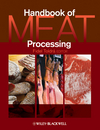Show Preview: IFFA 2016
IFFA 2016: Showcase of modern meat-processing




IFFA 2016 will open its doors in Frankfurt am Main, Germany, from May 7-12, 2016, and once again give trade visitors the opportunity to gather in-depth information about machinery and equipment for all stages of the process chain, from slaughtering to production and onward to packaging.
Today, the focus of the meat-processing industry is increasingly on intelligent linkage of the individual stages and the increased use of modern information and control technology. Thus, the range of products and services being offered by IFFA exhibitors for these subjects is correspondingly extensive.
Exact portioning and sorting
An important driving force of innovation behind increasingly efficient processing lines is the growing demand for portioned and fixed-weight packaging, and convenience products. The fully automatic portioning and insertion into packaging of filets, steaks, sausage slices and other meat products calls for high-tech solutions. Most systems consist of laser and/or X-ray scanners, with integrated scales, feeding units for the slicer and the slicer itself installed at the top of the processing line. Additionally, downstream conveyor belts take the cut products to multitrack belt sorters with sophisticated shuttle systems or sorting and insertion robots that, for example, place the packages in the downstream tray-sealer.
Robot-aided automation = value-added
Conventional automation is often too complex, too expensive and, in particular, insufficiently flexible. In most cases, converting machines designed for specific tasks is impracticable or only possible with a big input of materials, time and money.
This, however, is not the case with industrial robots. Thanks to their extraordinary flexibility, speed, precision and repeat accuracy, they are key elements for greater efficiency, quality and sustainability no matter the task (e.g., product handling, quality control or sorting and packaging). But what characterizes a successful robot application?
Superficially, an industrial robot can only move a fictive tool-center point quickly, precisely and with a high degree of repeat accuracy within a defined working area. It is the grabber or tool, the cameras and sensors, highly developed software, intelligent control systems and the programming/configuration by qualified personnel that make robots universal helpers.
Today, they are to be found in almost all parts of the meat-processing chain — from slaughtering to packaging meat and sausage portions. In fast pick-and-place operations, robots can take all different kinds of meat and sausage products from conveyor belts and place them in the correct trays, in some cases at the rate of up to 240 cycles per minute.
In smokehouses, using manual labor to hang and transfer smoke sticks with strings of sausages is frequently a bottleneck. Moreover, it is time, personnel and cost-intensive. Robots can carry out this work more precisely and faster. In addition to personnel savings, the advantages include a significant increase in terms of hygiene thanks to the abolition of manual operations, as well as a reduction in wasted product because there is no damage to the sausages, something that is often unavoidable in manual operation.
Robot-aided automation in slaughtering and dismembering facilities continues to be one of the biggest technical challenges. A task that humans can master thanks to their senses and many years of experience is a major problem for robots. Due to different rates of growth, animals vary greatly in terms of weight, size and the proportion of meat to fat, as well as bone size and density.
Nevertheless, there are also some economic, high-performance solutions in this field. The spectrum of applications includes grasping front-leg hooves and necks, removing the rectum, opening the abdominal wall, separating the pelvic bone and sternum, as well as splitting pigs, all of which is made possible by advanced 3-D scanners that determine the topology of the animals after slaughtering. The information obtained is analyzed by the control software, which then generates the cutting paths to be used by the robot. In dismembering plants, the robot blades are controlled via vision software.
X-ray for inline fat analysis
The still widespread extraction of lipid using the Soxhlet process is not only time- and labor-intensive, but it also is, due to the sampling procedure, not particularly accurate. Today, technology is developing more and more in the direction of continuous inline checks and modern X-ray technology in accordance with the DEXA process. This is a highly efficient method of lipid determination and suitable for raw, natural meat products, including refrigerated or frozen meat, lose or packed in boxes or cartons — as long as they are free of other ingredients. Thus, X-ray technology offers users continuous, 100-percent product control including data documentation for traceability.
These examples represent only a fraction of the possibilities opened up by modern automation for meat and sausage processing. Visitors to IFFA 2016 will have the chance to find out in-depth about the state-of-the-art and future developments in this field. Approximately 960 exhibitors from 47 countries, including all market and technology leaders, have signed up to present their latest products and innovations at the six-day expo.
Altogether, IFFA will cover 110,000 square meters of exhibition space in seven exhibition halls and is already almost fully booked. Messe Frankfurt expects to welcome around 60,000 trade visitors from 140 countries. Detailed information about IFFA can be found at www.iffa.com. NP
Looking for a reprint of this article?
From high-res PDFs to custom plaques, order your copy today!










